
Passetto di Borgo: The Secret Passage of the Popes
Explore the Passetto di Borgo, Vatican City's secret passageway that connects the Vatican to Castel Sant'Angelo, offering a unique glimpse into papal history and intrigue.
The Passetto di Borgo, often simply called the Passetto, is a hidden gem in the heart of Vatican City. This ancient elevated passageway connects the Vatican to Castel Sant'Angelo, offering a unique glimpse into the history and strategic ingenuity of the papal state. Built in 1277 by Pope Nicholas III, the Passetto was designed as an escape route for the Pope and other high-ranking officials during times of danger. Today, it stands as a fascinating historical structure, steeped in mystery and intrigue. Walking through the Passetto di Borgo is like stepping back in time. The narrow, cobbled corridor echoes with centuries of history, from the medieval era to the Renaissance. It was famously used by Pope Clement VII during the Sack of Rome in 1527, when he fled to the safety of Castel Sant'Angelo. The passageway's walls are lined with ancient stone, and the small windows offer fleeting glimpses of the bustling modern city below, creating a stark contrast between past and present. Visitors to the Passetto can enjoy guided tours that delve into the rich history of this secretive passage. These tours often include access to areas of both the Vatican and Castel Sant'Angelo that are not typically open to the public, providing a unique and comprehensive understanding of the passage's role in the Vatican's history. Whether you're a history buff or simply curious about the hidden corners of Vatican City, the Passetto di Borgo is a must-see destination.
Local tips in Passetto di Borgo
- Book your guided tour in advance, as slots can fill up quickly, especially during peak tourist seasons.
- Wear comfortable shoes; the cobbled path can be uneven and requires a fair bit of walking.
- Visit early in the morning or late in the afternoon to avoid the midday heat and crowds.
- Combine your visit with a tour of Castel Sant'Angelo to get a full experience of the passage's historical significance.
- Keep an eye out for special events or exhibitions that might be taking place in the passageway or the surrounding areas.
Passetto di Borgo: The Secret Passage of the Popes
The Passetto di Borgo, often simply called the Passetto, is a hidden gem in the heart of Vatican City. This ancient elevated passageway connects the Vatican to Castel Sant'Angelo, offering a unique glimpse into the history and strategic ingenuity of the papal state. Built in 1277 by Pope Nicholas III, the Passetto was designed as an escape route for the Pope and other high-ranking officials during times of danger. Today, it stands as a fascinating historical structure, steeped in mystery and intrigue. Walking through the Passetto di Borgo is like stepping back in time. The narrow, cobbled corridor echoes with centuries of history, from the medieval era to the Renaissance. It was famously used by Pope Clement VII during the Sack of Rome in 1527, when he fled to the safety of Castel Sant'Angelo. The passageway's walls are lined with ancient stone, and the small windows offer fleeting glimpses of the bustling modern city below, creating a stark contrast between past and present. Visitors to the Passetto can enjoy guided tours that delve into the rich history of this secretive passage. These tours often include access to areas of both the Vatican and Castel Sant'Angelo that are not typically open to the public, providing a unique and comprehensive understanding of the passage's role in the Vatican's history. Whether you're a history buff or simply curious about the hidden corners of Vatican City, the Passetto di Borgo is a must-see destination.
When is the best time to go to Passetto di Borgo?
Iconic landmarks you can’t miss
Vatican Museums
Explore the Vatican Museums, a treasure trove of art and history featuring the iconic Sistine Chapel and masterpieces by legendary artists.
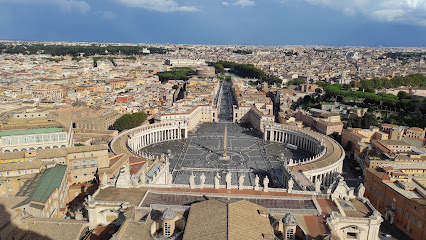
St. Peter's Basilica
Explore St. Peter's Basilica, a masterpiece of Renaissance architecture and a spiritual center in Vatican City, home to breathtaking art and historic significance.

Castel Sant'Angelo
Discover the enchanting Castel Sant'Angelo in Rome, a majestic fortress steeped in history, art, and breathtaking views of the Eternal City.

Sistine Chapel
Explore the Sistine Chapel, a stunning masterpiece of Renaissance art and a pivotal site for Catholic faith in Vatican City, inspiring awe and reverence.

Saint Peter's Square
Experience the grandeur of Saint Peter's Square, a masterpiece of architecture and spirituality in the heart of Vatican City.

St. Angelo Bridge
Discover the beauty of St. Angelo Bridge, a historic landmark connecting Rome and Vatican City, with stunning views and rich history around every corner.

St. Peter Square Obelisk
Discover the rich history and spiritual significance of the St. Peter Square Obelisk, a monumental landmark in Vatican City that enchants visitors with its grandeur.

Gardens of Vatican City
Discover the serene beauty and historical significance of the Gardens of Vatican City, a tranquil oasis in the heart of the world’s smallest state.

Apostolic Palace
Discover the splendor of the Apostolic Palace, the Pope's official residence, and immerse yourself in the rich history and art of Vatican City.

Vatican Necropolis
Discover the Vatican Necropolis, an ancient burial site revealing the rich history of early Christianity beneath St. Peter's Basilica in Vatican City.

Al Passetto di Borgo
Discover the flavors of Italy at Al Passetto di Borgo, where authentic dishes and a charming atmosphere await in the heart of Rome.
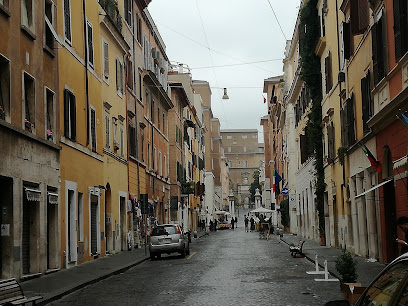
Vatican Style Rome
Discover the charm of Vatican Style Rome, your cozy Bed & Breakfast just steps from the Vatican, blending comfort with an authentic Roman experience.
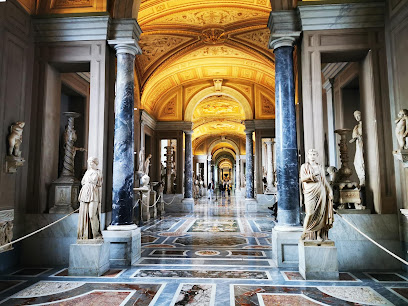
Vatican Hill
Discover the spiritual heart of Vatican City at Vatican Hill, where breathtaking views meet rich historical significance and artistic treasures.

Fontana delle Tiare
Discover the beauty of the Fontana delle Tiare, a stunning Roman fountain nestled in Vatican City's historic heart, perfect for serene moments and memorable photos.

Relais Vatican View
Discover comfort and elegance at Relais Vatican View, your ideal refuge just steps away from Vatican City in the heart of Rome.

Unmissable attractions to see
Piazza Vittorio Emanuele II
Explore the vibrant Piazza Vittorio Emanuele II, a cultural gem in Rome filled with history, lush gardens, and local markets.

IKONO Roma
Explore the immersive art and technology experiences at IKONO Roma, a must-visit tourist attraction in the heart of Rome.

Capannelle Racecourse
Discover the excitement of horse racing and Italian culture at Capannelle Racecourse, a premier sports complex in Rome.

Porta Maggiore
Explore the historic Porta Maggiore, a monumental gateway in Rome that blends ancient architecture with vibrant urban life, a must-visit for every traveler.

Museo Nazionale Romano, Palazzo Altemps
Discover the exquisite art and archaeological wonders of Museo Nazionale Romano, Palazzo Altemps in the heart of Rome.

Giulio Cesare - Circuito Cinema
Discover the cinematic charm of Giulio Cesare - Circuito Cinema in Rome, where contemporary films meet rich Italian cinematic history.

Basilica dei Santi Pietro e Paolo
Discover the breathtaking beauty and spiritual significance of the Basilica dei Santi Pietro e Paolo in Rome, a must-visit for every tourist.

Mausoleo Delle Fosse Ardeatine
Explore the Mausoleo Delle Fosse Ardeatine in Rome, a powerful memorial honoring the victims of World War II and a place for reflection and remembrance.

Casina delle civette
Explore the whimsical Casina delle Civette, a stunning architectural gem in Villa Torlonia, showcasing art and enchanting gardens in the heart of Rome.

TopBike Rental & Tours
Explore the Eternal City on two wheels with TopBike Rental & Tours, offering bike rentals and guided tours for an unforgettable Italian adventure.

Faro di Roma
Explore the Faro di Roma, a historic lighthouse on Gianicolo Hill, offering stunning views and a glimpse into Rome's maritime heritage.
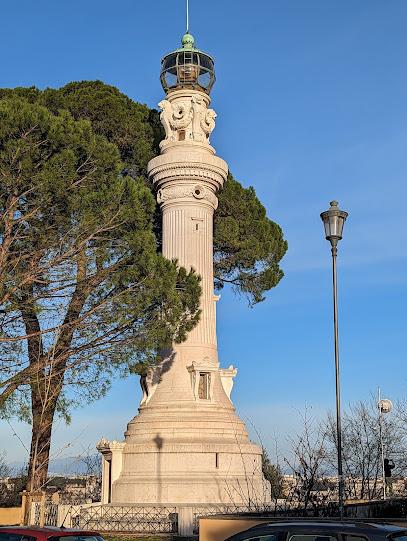
Museo Carlo Bilotti
Explore a vibrant blend of contemporary and modern art at the Museo Carlo Bilotti, a cultural treasure nestled in the heart of Rome.
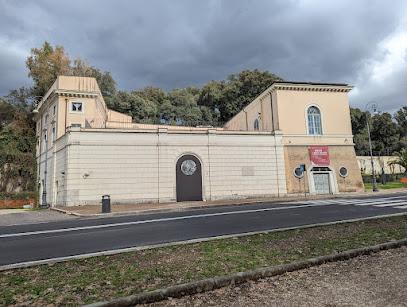
San Giorgio in Velabro
Explore the enchanting San Giorgio in Velabro, a historic church in Rome offering stunning architecture and a serene atmosphere for visitors seeking spiritual and artistic heritage.
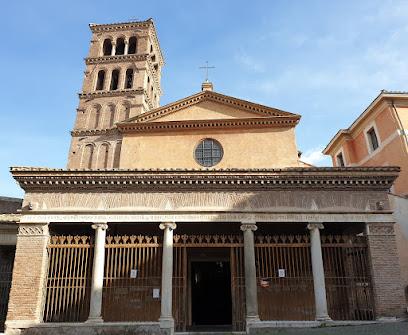
Cinecittà Si Mostra
Explore the magic of Italian cinema at Cinecittà Si Mostra, where film history comes alive in the legendary Cinecittà studios.
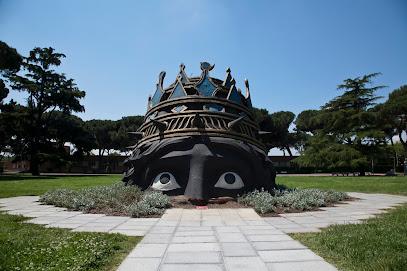
Temple of Venus and Rome
Explore the Temple of Venus and Rome, an iconic open-air museum that encapsulates the grandeur of ancient Rome and its divine heritage.

Essential places to dine
Pastasciutta
Experience authentic Italian cuisine at Pastasciutta in Rome - delicious pasta dishes served fast and affordably.

Borghiciana Pastificio Artigianale
Discover authentic Roman cuisine at Borghiciana Pastificio Artigianale – where tradition meets taste in every dish.

Ristorante Arlù
Experience authentic Italian cuisine at Ristorante Arlù in Rome's historic Borgo Pio district - where every dish tells a story.
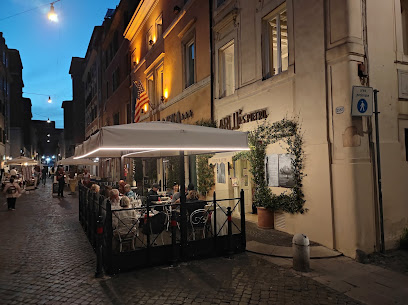
La Locanda di Pietro
Discover La Locanda di Pietro: An authentic Italian restaurant in Rome serving delicious Mediterranean cuisine and renowned pizzas.

Scialla The Original Street Food
Experience authentic Roman street food at Scialla: savor delicious pizzas and local wines in an inviting atmosphere.

Rione XIV Bistrot
Experience the essence of Roman cuisine at Rione XIV Bistrot, where tradition meets culinary excellence in every bite.

Osteria delle Commari
Experience authentic Italian flavors at Osteria delle Commari in Rome, offering gluten-free options and a cozy atmosphere for all food lovers.

Tre Pupazzi Restaurant
Experience the fusion of Portuguese and Italian flavors at Tre Pupazzi Restaurant in Rome's enchanting atmosphere.

L'Angoletto ai Musei
Experience authentic Italian cuisine at L'Angoletto ai Musei in Rome—where every meal is a celebration of flavor and tradition.

Ristorante Trattoria Da Marcella
Discover authentic Italian flavors at Ristorante Trattoria Da Marcella in Rome – where every dish tells a story.

Ristorante Il Pozzetto
Experience authentic Italian cuisine at Ristorante Il Pozzetto, where family-friendly dining meets delicious Mediterranean flavors in Rome's charming Borgo Pio.

BorgoPio92 Bistrò Caffè
Experience authentic Italian flavors at BorgoPio92 Bistrò Caffè near Vatican City—delicious meals, cozy ambiance, and delightful treats await!

Ristorante Krugh
Experience authentic Roman flavors at Ristorante Krugh, where traditional dishes meet warm hospitality in the heart of Rome.

Al Passetto di Borgo
Experience authentic Italian flavors at Al Passetto di Borgo, where tradition meets modern culinary artistry in the heart of Rome.

Piacere Molise
Experience authentic Italian cuisine at Piacere Molise - renowned for delicious pizzas and traditional dishes in the heart of Rome.

Markets, malls and hidden boutiques
The Rock Shop
Discover the essence of rock and roll at The Rock Shop in Rome, where fashion meets music memorabilia for an unforgettable shopping experience.

Annona Vatican City
Explore Annona in Vatican City for the freshest local produce and a taste of authentic Italian cuisine, perfect for culinary enthusiasts.

Savelli Religious (Savelli Art and Tradition)
Explore Savelli Religious in Rome for unique spiritual gifts, exquisite jewelry, and a taste of Italy's rich cultural heritage.

Mondo Cattolico
Explore Mondo Cattolico for unique religious artifacts and souvenirs in the heart of Vatican City, a must-visit for every traveler.

St. Peter's Gallery
Experience the allure of St. Peter's Gallery, a unique gift shop near St. Peter's Basilica, offering artisanal souvenirs and delightful coffee in Rome.

Vatican Emporium - Religious Articles & Gifts
Explore the Vatican Emporium for authentic religious articles and gifts in the heart of Rome, capturing the essence of faith and tradition.

Tourist Information Office
Explore the heart of Vatican City at the Tourist Information Office—your source for souvenirs, books, and invaluable visitor information.

Leather Center Rome - Ancient leather of the village
Explore the Leather Center in Rome for exquisite handcrafted leather goods, blending tradition with modern elegance in the heart of the city.

Capriotti
Discover a unique blend of religious artifacts and local souvenirs at Capriotti, a must-visit store in the heart of Rome.

New Old
Discover unique souvenirs and artisanal treasures at New Old, the charming gift shop in the heart of Rome that captures Italian craftsmanship.

Galleria Mariana
Discover the spiritual heart of Rome at Galleria Mariana, your destination for authentic religious goods and unique souvenirs.

Souvenirs San Pietro Sas di Ferru Zenobio E C.
Discover authentic religious souvenirs and unique gifts at Souvenirs San Pietro, a charming store near the Vatican in Rome.

Borgo Shop
Explore Borgo Shop in Rome for exquisite religious goods and a glimpse into the city's spiritual heritage.

Turella Adriana Snc
Discover unique religious artifacts and souvenirs at Turella Adriana, a charming store in Rome's historic Borgo Pio district.
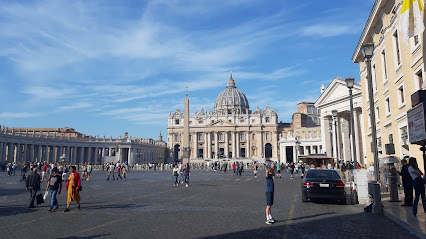
Bernardi Souvenirs
Discover the essence of Rome at Bernardi Souvenirs, your go-to shop for unique religious artifacts and cherished mementos.

Essential bars & hidden hideouts
Terrazza Les Étoiles Roma
Experience breathtaking views and exquisite cuisine at Terrazza Les Étoiles, Rome's premier rooftop restaurant and bar for unforgettable moments.
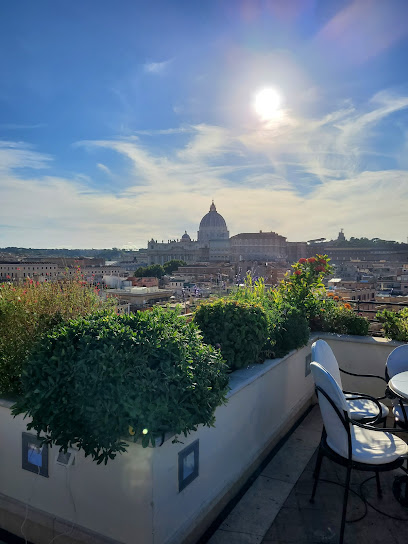
Be.Re. + Trapizzino
Discover the taste of Rome at Be.Re. + Trapizzino, a gastropub offering innovative Italian street food and a cozy atmosphere near the Vatican.

Wine Bar De' Penitenzieri
Discover the enchanting Wine Bar De' Penitenzieri in Rome, where exquisite wines and delightful cuisine come together in a warm and welcoming atmosphere.
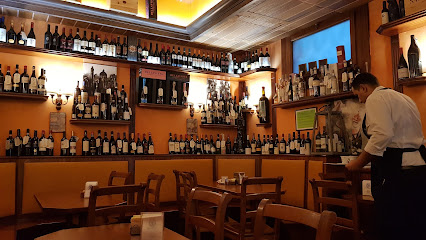
Morrison's
Discover the charm of Ireland at Morrison's, a lively pub in Rome serving delicious food and drinks in a welcoming atmosphere.

Bukowski's Bar
Discover Bukowski's Bar: A vibrant bistro in Rome serving delightful dishes and an extensive drink menu, perfect for an authentic Italian experience.

The Basement - Pub. Cocktail Bar. Events
Experience the vibrant nightlife at The Basement, Rome's trendy pub and cocktail bar, perfect for socializing and enjoying local events.

Saxophone Live Pub
Experience the vibrant nightlife of Rome at Saxophone Live Pub, where live music and great drinks come together for an unforgettable evening.

American bar - Vecchio Borgo S.r.l.
Experience the essence of Rome at Vecchio Borgo, where delightful cocktails and sundaes await in a charming atmosphere.
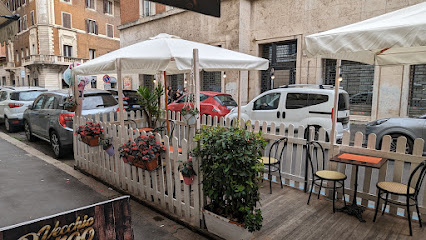
Ginny | Cocktail Bar | Wine Bar | Ristorante
Discover Ginny in Rome: a vibrant cocktail bar and restaurant offering exquisite drinks and a taste of local Italian cuisine.
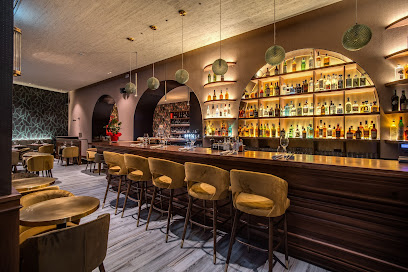
Bar Latteria Giuliani
Discover the authentic flavors of Italy at Bar Latteria Giuliani, a cozy bar in Rome's Borgo Pio, perfect for coffee lovers and pastry enthusiasts.
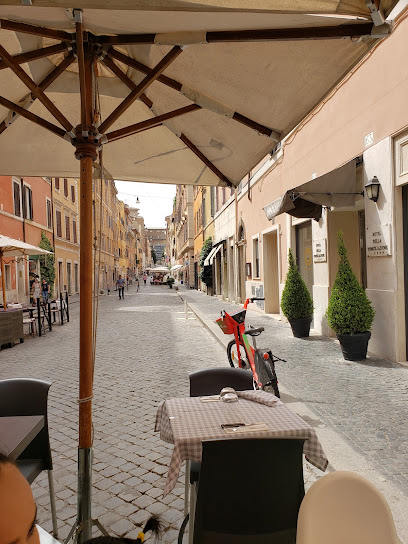
Universal Bar Pizzeria
Experience authentic Italian cuisine and vibrant atmosphere at Universal Bar Pizzeria, a true gem in the heart of Rome.

Caffè Leonina
Experience the charm of Roman café culture at Caffè Leonina, where every sip transports you to the heart of Italy.
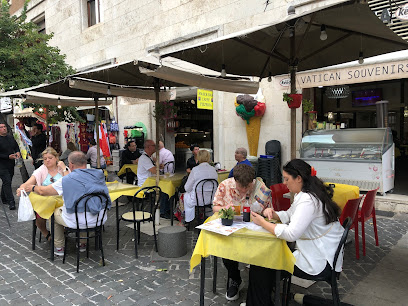
Roof Garden & Bar
Discover breathtaking views and delightful cocktails at the Roof Garden & Bar, a serene rooftop escape in the heart of Rome.

Bar Delle Grazie
Experience authentic Roman hospitality at Bar Delle Grazie, a charming bar offering delicious coffee, local wines, and a welcoming atmosphere.

Al Mio Caffè
Experience the rich flavors of Italy at Al Mio Caffè, a charming bar in the heart of Rome offering exquisite coffee and pastries.

Local Phrases about Passetto di Borgo
-
- HelloCiao
[chow] - GoodbyeArrivederci
[ah-ree-veh-dehr-chee] - YesSì
[see] - NoNo
[noh] - Please/You're welcomePer favore/Prego
[pehr fah-voh-reh/preh-goh] - Thank youGrazie
[grah-tsee-eh] - Excuse me/SorryMi scusi/Scusa
[mee skoo-zee/skoo-zah] - How are you?Come stai?
[koh-meh stai] - Fine. And you?Bene. E tu?
[beh-neh. eh too] - Do you speak English?Parli inglese?
[pahr-lee een-gleh-zeh] - I don't understandNon capisco
[nohn kah-pee-skoh]
- HelloCiao
-
- I'd like to see the menu, pleaseVorrei vedere il menù, per favore
[vohr-ray veh-deh-reh eel meh-noo, pehr fah-voh-reh] - I don't eat meatNon mangio carne
[nohn mahn-joh cahr-neh] - Cheers!Salute!
[sah-loo-teh] - I would like to pay, pleaseVorrei pagare, per favore
[vohr-ray pah-gah-reh, pehr fah-voh-reh]
- I'd like to see the menu, pleaseVorrei vedere il menù, per favore
-
- Help!Aiuto!
[ah-yoo-toh] - Go away!Vai via!
[vah-ee vee-ah] - Call the Police!Chiama la polizia!
[kyah-mah lah poh-leet-zee-ah] - Call a doctor!Chiama un dottore!
[kyah-mah oon doh-toh-reh] - I'm lostMi sono perso
[mee soh-noh pehr-soh] - I'm illMi sento male
[mee sehn-toh mah-leh]
- Help!Aiuto!
-
- I'd like to buy...Vorrei comprare...
[vohr-ray kohm-prah-reh] - I'm just lookingSto solo guardando
[stoh soh-loh gwar-dahn-doh] - How much is it?Quanto costa?
[kwahn-toh koh-stah] - That's too expensiveÈ troppo caro
[eh troh-poh cahr-oh] - Can you lower the price?Puoi abbassare il prezzo?
[pwah-ee ahb-bahs-sah-reh eel preh-tsoh]
- I'd like to buy...Vorrei comprare...
-
- What time is it?Che ore sono?
[keh oh-reh soh-noh] - It's one o'clockÈ l'una
[eh loo-nah] - Half past (10)Sono le dieci e mezza
[soh-noh leh dyeh-chee eh meh-tzah] - MorningMattina
[mah-tee-nah] - AfternoonPomeriggio
[poh-meh-ree-joh] - EveningSera
[seh-rah] - YesterdayIeri
[yeh-ree] - TodayOggi
[oh-jee] - TomorrowDomani
[doh-mah-nee] - 1Uno
[oo-noh] - 2Due
[doo-eh] - 3Tre
[treh] - 4Quattro
[kwah-troh] - 5Cinque
[cheen-kweh] - 6Sei
[say] - 7Sette
[seht-teh] - 8Otto
[oh-ttoh] - 9Nove
[noh-veh] - 10Dieci
[dyeh-chee]
- What time is it?Che ore sono?
-
- Where's a/the...?Dov'è un/il...?
[doh-veh oon/eel] - What's the address?Qual è l'indirizzo?
[kwal eh leen-dee-reet-zoh] - Can you show me (on the map)?Puoi mostrarmi (sulla mappa)?
[pwah-ee mohs-trahr-mee (sool-lah mahp-pah)] - When's the next (bus)?Quando passa il prossimo (autobus)?
[kwahn-doh pahs-sah eel prohs-see-moh (ow-toh-boos)] - A ticket (to ....)Un biglietto (per ....)
[oon bee-lyet-toh (pehr)]
- Where's a/the...?Dov'è un/il...?
History of Passetto di Borgo
-
Passetto di Borgo, often simply referred to as 'il Passetto,' is an elevated passageway that connects the Vatican City with the Castel Sant'Angelo. Constructed in the late 13th century, this corridor has played a significant role in the history of the papacy, providing a secret escape route for Popes in times of danger. Stretching approximately 800 meters, the fortified corridor weaves through the heart of Rome, offering a tangible connection to the city's storied past.
-
Commissioned by Pope Nicholas III in 1277, the Passetto di Borgo was built as part of a larger fortification effort to protect the papal residence. The corridor is constructed of brick and stone, featuring a series of crenellated walls and defensive towers. Its strategic design includes narrow windows for archers, making it a formidable defensive structure. Over the centuries, various Popes have ordered repairs and reinforcements, ensuring its continued utility and preservation.
-
One of the most significant events in the history of Passetto di Borgo occurred during the Sack of Rome in 1527. As the troops of Charles V, Holy Roman Emperor, invaded the city, Pope Clement VII found refuge in the Castel Sant'Angelo by fleeing through the Passetto. The corridor's existence was crucial in ensuring his safety, as the city of Rome fell into chaos and destruction. This event underscored the importance of the Passetto as a lifeline for the papacy in perilous times.
-
Throughout its history, the Passetto di Borgo has been used by various Popes to escape threats and seek sanctuary. Notable instances include Pope Alexander VI, who used the corridor to flee from Charles VIII of France in 1494. Its discreet passageway allowed the Popes to move between the Vatican and the Castel Sant'Angelo without attracting attention, making it an invaluable asset during periods of political instability and military conflict.
-
In recent decades, efforts have been made to restore and preserve the Passetto di Borgo, allowing visitors to explore this historic corridor. Restoration projects have focused on stabilizing the structure, repairing damage, and making it accessible to the public. Today, guided tours offer a unique opportunity to walk in the footsteps of history, providing an immersive experience of the corridor's architectural features and its role in the papal history. The Passetto stands as a testament to the resilience and resourcefulness of the Vatican throughout the centuries.
Passetto di Borgo Essentials
-
Passetto di Borgo is located in Vatican City, easily accessible from Rome. The nearest international airport is Leonardo da Vinci–Fiumicino Airport (FCO), approximately 30 kilometers away. From the airport, you can take the Leonardo Express train to Roma Termini station, then transfer to the Metro Line A (red line) and get off at Ottaviano-San Pietro. Alternatively, a taxi or airport shuttle service can take you directly to Vatican City.
-
Within Vatican City, walking is the primary mode of transportation, as it is a small area. For exploring Rome, public transportation options include buses, trams, and the metro. The ATAC public transport system is reliable and extensive. Taxis are also available but ensure they are licensed to avoid scams. Renting a bike or a scooter can be a fun way to navigate the city, especially during warmer months.
-
The official currency in Vatican City is the Euro (EUR). Credit cards are widely accepted in hotels, restaurants, and shops within Vatican City and Rome. However, it is advisable to carry some cash for small purchases and in case you encounter establishments that only accept cash. ATMs are plentiful, and you can easily withdraw Euros using your debit or credit card.
-
Vatican City and its surrounding areas in Rome are generally safe for tourists. However, be cautious of pickpockets, especially in crowded areas like St. Peter's Square and public transport. Avoid walking alone late at night in poorly lit areas. The neighborhoods around Vatican City, such as Prati, are relatively safe, but always stay vigilant and aware of your surroundings.
-
In case of an emergency, dial 112 for immediate assistance. This number connects you to emergency services including police, medical, and fire departments. Vatican City has its own security services, but for major emergencies, you may be assisted by Italian authorities. It's highly recommended to have travel insurance that covers medical emergencies. There are several hospitals and clinics in Rome, such as Ospedale Santo Spirito, which is close to Vatican City.
-
Fashion: Do dress modestly, especially when visiting religious sites. Avoid wearing shorts, sleeveless tops, and revealing clothing. Religion: Do respect local customs and traditions. Silence your phone and avoid loud conversations in religious areas. Public Transport: Do validate your ticket before boarding. Don't eat or drink on public transport. Greetings: Do greet people with a polite 'Buongiorno' (Good morning) or 'Buonasera' (Good evening). Eating & Drinking: Do try local Italian delicacies and Vatican-specific dishes. Don't refuse food or drink offerings, as it may be considered impolite.
-
To experience Passetto di Borgo like a local, consider visiting during early morning or late afternoon to avoid the crowds. Take your time to appreciate the historical significance of the passageway. Engage with local guides who can provide in-depth historical context. Enjoy a meal at one of the local trattorias in the nearby Borgo Pio area, where you can savor authentic Roman cuisine. Don't miss the opportunity to attend a Papal audience or mass at St. Peter's Basilica for a unique and spiritual experience.
Trending Landmarks in Passetto di Borgo
Nearby Cities to Passetto di Borgo
-
Things To Do in Apostolic Palace
-
Things To Do in Sistine Chapel
-
Things To Do in St. Peter's Basilica
-
Things To Do in Vatican Necropolis
-
Things To Do in Gregorian Etruscan Museum
-
Things To Do in Vatican Museums
-
Things To Do in Vatican Pinacoteca
-
Things To Do in Vatican Gardens
-
Things To Do in Rome
-
Things To Do in Orvieto
-
Things To Do in Assisi
-
Things To Do in Perugia
-
Things To Do in Montepulciano
-
Things To Do in Arezzo
-
Things To Do in Siena








